I would argue that the 12V electrical system in your RV is the most critical system in there. Without functioning 12V, the vast majority of the other systems are of no value. No Slides, no water (pump), no heat (furnace), no fridge, no hot water, no lights, etc, etc. Getting the most from your RV batteries extends your ability to camp when not connected to the grid and still maintain all the comforts of home.
Before we get started, you should have a basic Understanding of RV Electrical Systems and taking a peek at our Starting Guide to Boondocking (the electrical section) could also be useful.
There are volumes of information out on the interwebs about this subject. The goal here is not to dig into the deep chemistry or things like the Peukert effect when charging, but instead to be a useful guide for general use by people who camp.
Basics
A battery is simply a device we use to store electricity. We can then draw on that store to run various systems in the RV. Like we measure water storage in gallons, we measure battery storage in Amp Hours (Ah). The more Ah you can store in your batteries, the more systems or the longer you can go before you need to replenish your batteries.
As someone who boondocks, the goal should be fitting the most amount of amp hours you can fit into the space you have available as well as aligning with your budget.
Camping where you have electrical hookup, a simple and cheap marine battery is all that is required. If that is the case, you can honestly skip this review and save some of your time.
However, for the rest of you, I’m going to boil down the basics of what it means and try to help you decide on the battery solution that is right for you.
Types of Batteries
There are many technologies (chemistries) that can create a battery. In the RV world there are really only 2 that are commonly used. Lead Acid or Lithium Iron Phosphate (LiFePO4). There are advantages and disadvantages to each that we’ll cover below.
Lead Acid
The vast majority of RV’s on the market and the road use Lead Acid batteries for their 12V systems. This type of battery technology is used lots of different applications such as cars, golf carts, forklifts and boats. The technology was invented in the mid 1800’s meaning their characteristics are VERY well understood and haven’t changed in forever. They tend to be affordable due to wide usage and inexpensive components.
https://en.wikipedia.org/wiki/Lead%E2%80%93acid_battery
Types of Lead Acid Batteries
For RV use the two most common types people use are Flooded or Absorbed Glass Mat (AGM).
Flooded
These are what I have always used. When looking for flooded batteries you want to get batteries that are designed for low current draw over an extended period of time. This is important because most of the batteries out there are Car batteries or Marine batteries – – most dealers install Marine batteries in your RV. Marine and Car batteries are designed to deliver a high amount of current over a short period of time (IE: Starting a motor).
You want to find batteries that are rated in Amp Hours. Cold Cranking Amps or Reserve Capacity (RC) as the measurement typically means the batteries are not the best kind of Deep Cycle battery for the RV house usage.
Flooded batteries are exactly that – they contain cells of fluid that is part acid. They also outgas Hydrogen and Sulfur Dioxide. Because of this they have to be stored and used in a right side up configuration and in a ventilated area.
Flooded batteries lose water with use and should be topped off periodically with distilled water. (WEAR SAFETY GLASSES). You can make it easier to fill with one of these.
AGM
A newer lead acid technology that doesn’t contain any liquid. This means they can be stored and used in any position and do not outgas enough to matter so they can be installed safely in enclosed areas, even in living areas of the camper.
They are considered maintenance free and it’s virtually impossible to damage them by freezing
AGM have the same electrical characteristics as flooded so you can use them as a drop in replacement. They do tend to cost 1.5 to 2 times more than an equivalent flooded battery.
Cold Weather

For camping in very cold weather you should keep a close eye on your state of charge as flooded batteries can freeze if they are not fully charged as shown above. Lead Acid have good tolerance to cold temperatures, and can be charged as long as they are not frozen. If they do freeze, they should be replaced.
Capacity
On the interwebs there is a lot of conversation and theory about the “BEST” lead acid batteries. As a rule of thumb you are looking for the most amount of available Ah’s that you can fit into the available space.
Another important consideration with Lead Acid is that you typically should only discharge them down to 50% for longest life and rarely if ever take them below 20% as that will have a serious impact on battery life.
6V vs 12V Batteries
The vast majority of RV’s use 12V as power source for all their house systems.. Most batteries you will find out there will be 12V units, just like in your car or truck. However its not always easy to find true Deep Cycle 12V batteries locally. You will easily find “Marine” batteries easily, but these aren’t really the best and are not usually rated in Ah’s. If you do find true deep cycle 12V batteries, they will typically be pretty expensive for the number of Ah’s you will get.
What you will likely be able to find are relatively inexpensive 6V “Golf Cart” batteries. These things are pretty prolific, the last ones I bought were from Costco of all places. Similar to this. The beauty of 6V Golf carts is they are true deep cycle, fairly cheap and readily available. Plus, you can take 2 of them, wire them in series and turn them into a single, large, 12V battery.
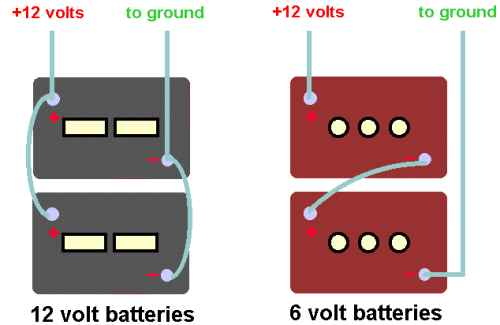
One thing to keep in mind, if you use 12V batteries the total number of amp hours is cumulative. So 2 x 100Ah batteries and you’ll have 200Ah’s available. With 6V batteries, the voltage is cumulative (combines to 12V) but the amperage is not. Mean 2 x 225Ah 6V batteries wired in series to give you 225Ah available power at 12V.
Lithium-Iron Phosphate (LiFePO4 or Lithium)
Ten years ago their were only a few folks who had built out their own Lithium RV battery system. It required them to piece together various components and often manage the charge profile themselves. It was one of those things you would only do if you REALLY knew what you were doing. Today there seem to be dozens of brands for not only the batteries, but the charge controllers, converters and other components needed to get the most from Lithium.
Don’t confuse these with other types of Lithium based batteries like Lihium Polimer or Lithium-Ion that you’ve seen burst into flames or explode. LiFePO4 is very stable. Any battery can be dangerous, but these are on the safe side.
Advantages
Lithium batteries can be installed in any orientation and even better weigh about 1/2 of what Lead Acid batteries do. Not only that but they should last through about 10X the number of charge cycles of a typical lead acid battery. They can take a charge at a much higher rate which decreases your generator time.
They don’t outgas anything so can be safely installed in the living space of the camper. And you can discharge them down to nearly 0%.
There are a LOT of advantages in Lithium for RV use.
Disadvantages
LiFePO4 batteries are considerably more expensive than lead acid. Because of their expected life is considerably longer, it may be a wash over the long haul, but it’s gonna hit your pocketbook out the gate.
Cold Weather charging is the other major disadvantage, in that you should never charge a LiFePO4 battery when it is below 32F outside or you risk damaging it. Most who use them relocate their battery bank from the outside into the living area of the camper so the batteries get to take advantage of the same heat that is keeping you comfy.
State of Charge
So, how do you know your current state of charge? There are basically 3 methods.
Measure Voltage – So-So
You can get a general idea of the state of your batteries by measuring the voltage.
If you don’t have a multimeter – get one. IMHO it should be part of the kit for every RVer. This is the one I keep in my truck toolbox. At home I have a 25 year old Fluke that I hope lasts forever!
Set the meter to measure Volts DC. Some low end ones (like my Harbor Freight freebie) have multiple volts-DC settings. Pick the lowest setting that is above the expected voltage. On my Harbor Freight, it’s 20V DC.
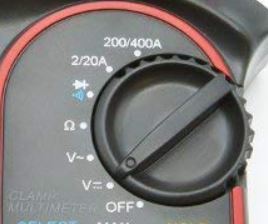
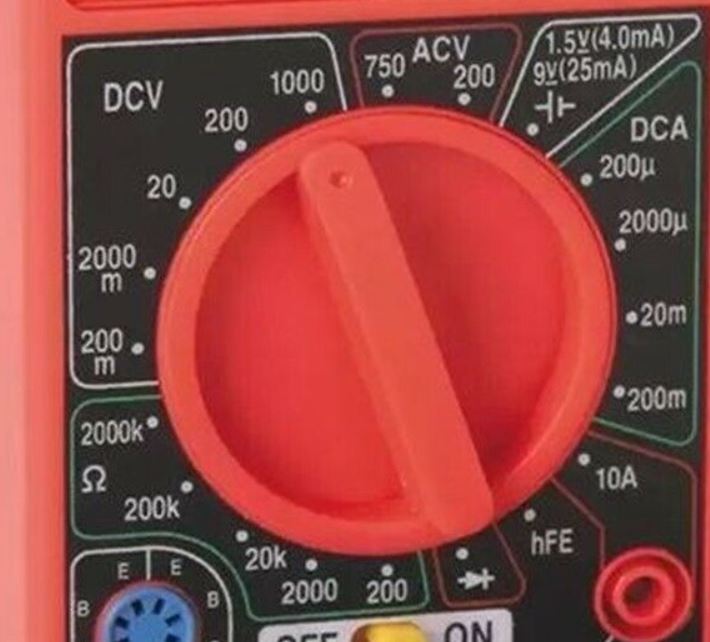
Lead Acid Voltage
For this to be accurate, the battery should sit with no charging or draw on them for 24 hours before you take the measurement. Yeah, not too convenient or practical when you are out camping – considering there is always something going in/out of the batteries.
The way I do this and get “pretty close” is picking a time when nothing major has been used in the RV, in particular NO CHARGING for the last couple of hours. This allows the majority of the phantom effect to drain off and will get you closer to a decent guess as to their state.
Now, put the red wire on the positive side of your battery and the black on the negative. You should get a voltage between 10.5V and 12.6. If you see more than 12.7, then there is something charging your batteries, or has been recently charging your batteries and you should try again in a couple more hours.
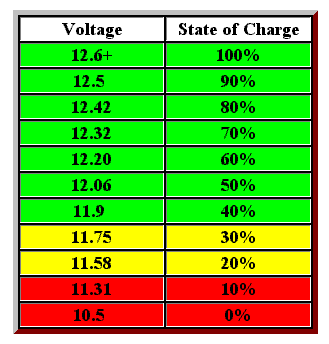
LiFePO4 Voltage
While LiFePO4 doesn’t have the “sit for 24 hours” issue that Lead Acid does, they also don’t have very much of a voltage change from full to nearly empty. Slight changes of 0.1V DC can represent up to 30% of capacity. Meaning you would need a very accurate multimeter to get a good guess. The good news is that many of the charge controllers for Lithium include a BMS or a stand alone BMS can be added.
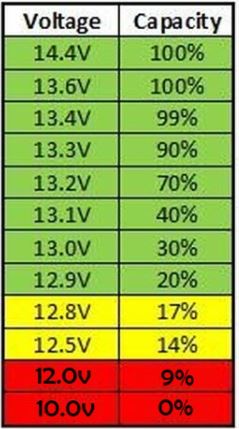
Battery Monitoring System (BMS) – Better
These things are pretty slick and work the same for lead acid or LiFePO4. A shunt gets connected to the negative side of your battery bank – BEFORE ANY OTHER CONNECTIONS. That shunt can then see all the power going in and out of your battery bank as well as measure the voltage.
Once all installed and hooked up, you will have to go through a setup routine that will let the monitor know things like the types of batteries you have as well as their capacity. With all that information, it is then able calculate how much capacity is still in your batteries.
I use the one made by Victron and am very happy with it.
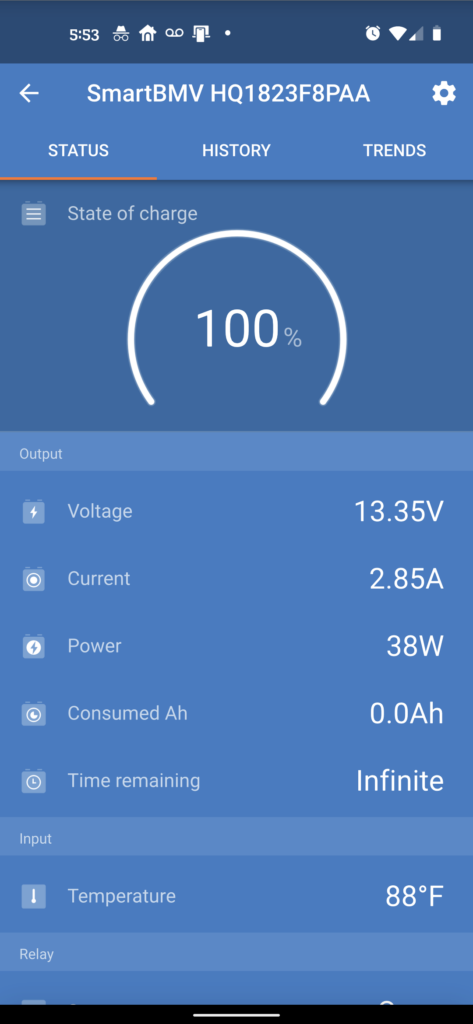
Hydrometer – Most Accurate for Lead Acid
A hydrometer is the most accurate way to see what the state of charge is on a Lead Acid battery, however it’s kind of a pain and few people actually do it. It works by sucking a bit of fluid out of each of the cells in your battery, one at a time. It measures the specific gravity of the fluid and then you test each cell individually to know where you sit. They should all read pretty close to each other. It is also useful for identifying a bad cell in a battery.
Capacity Planning
No matter the types of batteries being used, our end goal is to consume as few Amp Hours (Ah) as possible and to have the largest Ah battery bank possible. Think of as Ah as a gallon of electricity – we have a limited supply and want to use each one in the best way possible..
In our batteries, available Amp Hours (Ah) are what we need and want. Generally the Ah number correlates to how many hours the battery can run a 1 amp load. A typical RV incandescent light bulb pulls 1 amp, so if your battery has 50 Ah, that battery could run that bulb for 50ish hours. The end goal is to fit as many available Amp Hours (Ah) as possible into the space and weight constraints available. Of course cost comes into play as well.
Some folks on the internet expect you to “know” what you will use. Not really possible, but the concept of what systems in your RV use the most power is very helpful. How much power you consume will vary on every single trip depending on things like outside temp, activities, etc.
So to figure this out we need to look at how amps each of the items in our RV consume. Remember that if any one of these runs for an hour, that amp number is also how many Ah it pulled from our battery
- 0.5 to 1.5A Phantom loads like circuit boards and smoke/propane detectors (24×7 – this one doesn’t go away)
- 0.1A LED Light (many have 2 bulbs so double it)
- 1.0A Incandescent Light
- 7.0A Furnace Fan
- 4-8A Water Pump
- 1 to 3 Fantastic Fan
- 2 to 5A TV running off inverter with Fire Stick
- 4.5A DC Beer Cooler
For the purpose of this article we are not going into high draw things like coffee makers, hair dryers, portable heaters or air conditioners. That takes a LOT more thought and planning. Just as a thought exercise, a typical 1500W portable heater pulls 1500W/12V or 125 Amps! That doesn’t count the loss of converting that 12V DC into 120V AC.
The idea here is to minimize how much power you draw off the batteries in order to extend the amount of time you can stay off the grid. If ya need to dig into your specific usage, hop on over to the Member Community.
Summary – and what I do
In all my years of camping I’ve use lead acid batteries, but over the last few years have been watching Lithium very closely. In our first camper we had a single Marine style battery that likely had 70Ah – and it was enough for our weekend trips. We were VERY conservative on water and power usage in that camper.
And then, in every camper since, I’ve installed a pair of 6V Golf Cart batteries wired in series to give me around 225Ah of available capacity, 115Ah of that usable without damaging the batteries. Part of the beauty of these is they run about $100 each!
I go into more detail on battery consumption and my setup over in the Boondocking article.
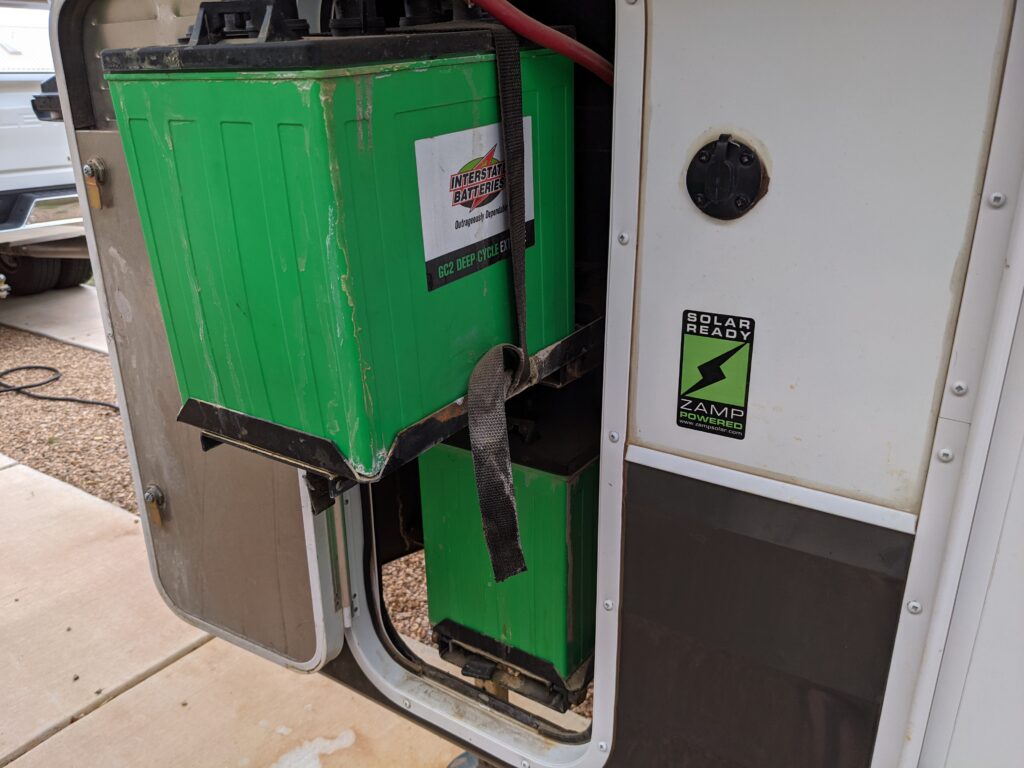
Over the years we’ve come to greatly appreciate the little things we can do when we have adequate battery power. Between this battery bank and my 400W of solar, we can use any of the systems as we need to. Including keeping my beer cold in a DC power beer cooler or watching a few hours of TV in the evenings. Please note, without the solar, the batteries can hold up that kind of usage for about 36 hours. With the solar (and decent sunlight) I can go indefinitely off the grid power wise. If we have a bad sun situation, I can shut down the cooler and use less TV and easily go 4-6 days off grid.
My current batteries are about 3 years old. Being maintained and de-sulfated by the Progressive Dynamics converter I would expect them to last at least 3 more years. They have never been discharged below 50% and hopefully won’t ever be.
I haven’t yet done Lithium for 2 reasons. First, they are expensive. An argument can be made that over their life the total cost could be less, but that is a WAYS down the road with typical 100Ah Battle Born’s going for $800-900 each. Plus I’d need a new converter and re-wiring to support the faster charging as well as re-locating the batteries into a heated space in the camper. All things I suspect I will do one day, but for now the Lead Acid 6V Golf Carts are meeting our needs.

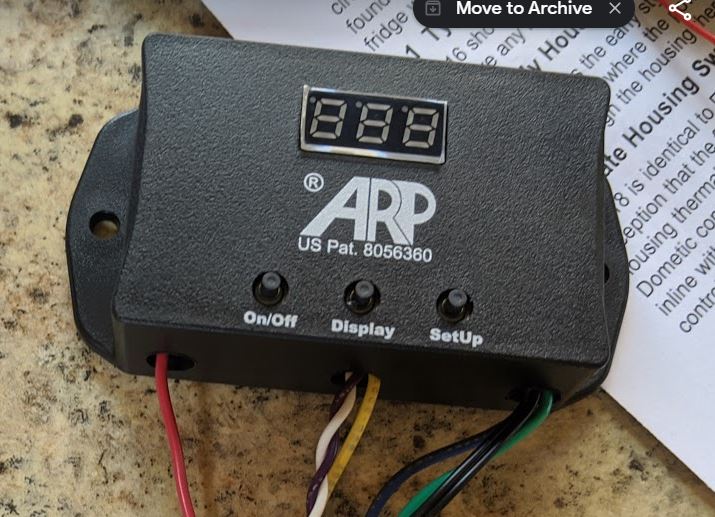
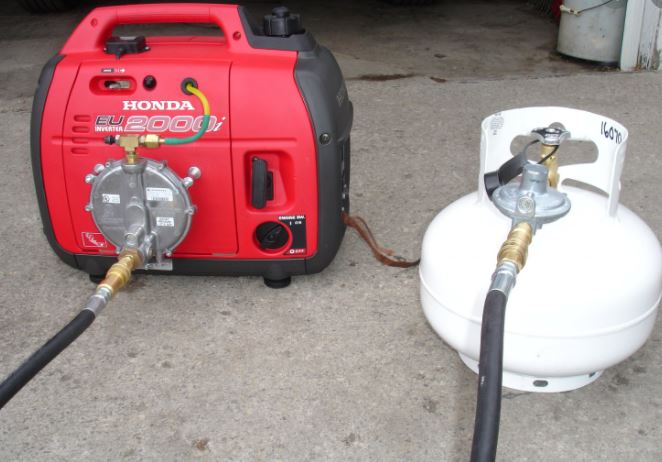
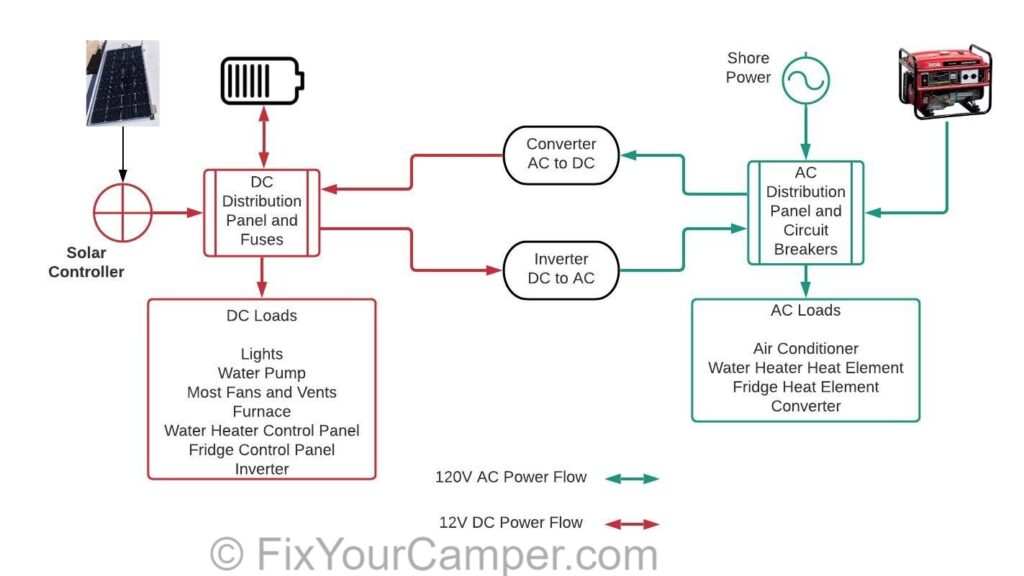
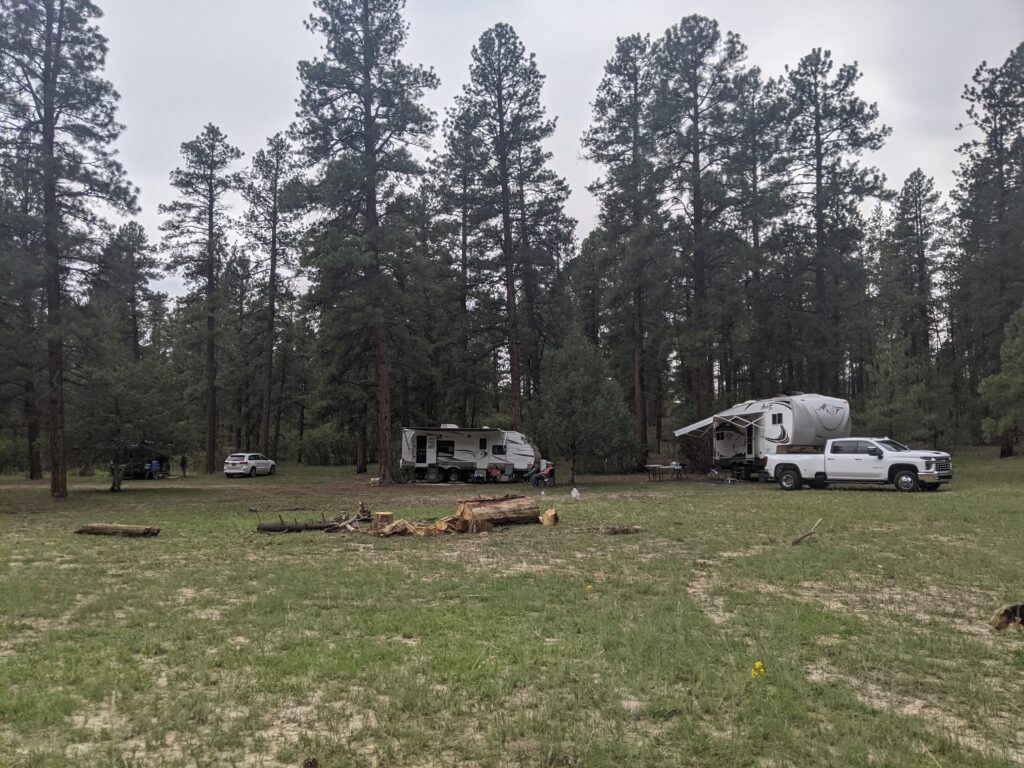
Pingback: Intro to Boondocking | Fix Your Camper